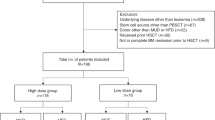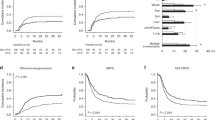Abstract
We investigated efficacy and safety of rabbit anti-thymocyte globulin (rATG), cyclosporine and granulocyte colony-stimulating factor (G-CSF) as first-line therapy for patients with aplastic anemia (AA) and low or intermediate-1 or hypoplastic myelodysplastic syndrome (MDS). rATG 3.5 mg/kg (or 2.5 mg/kg per day for patients ⩾55 years with MDS) was given for 5 days. Cyclosporine (5 mg/kg) and G-CSF (5 μg/kg) were given daily and continued for up to 6 months or longer. Responses were assessed about 3 and 6 months after therapy. Thirty-six patients have been enrolled on study and 32 patients treated; 25 were evaluable for a response (13 with AA, 12 with MDS); the rest are too early. The median age was 62 years (range, 20–83) for patients with AA and 63 (range, 42–80) for patients with MDS. Of 13 patients, 12 (92%) patients with AA responded (5 complete response (CR), 7 partial response (PR)), whereas of 12 patients, 4 (33%) patients with MDS responded (1 CR, 3 PR). For patients with AA, the median time to response (TTR) was 93 days (range, 79–623), whereas in the MDS group the median TTR was 111 days (range, 77–139). Grade III/IV toxicities were mainly cytopenias and neutropenic fever. Combination of rATG, cyclosporine and G-CSF is safe and effective as first-line treatment of AA and has significant activity in low-risk MDS.
This is a preview of subscription content, access via your institution
Access options
Subscribe to this journal
Receive 12 print issues and online access
$259.00 per year
only $21.58 per issue
Buy this article
- Purchase on Springer Link
- Instant access to full article PDF
Prices may be subject to local taxes which are calculated during checkout

Similar content being viewed by others
References
Young NS . Acquired aplastic anemia. Ann Intern Med 2002; 136: 534–546.
Young NS, Maciejewski J . The pathophysiology of acquired aplastic anemia. N Engl J Med 1997; 336: 1365–1372.
Barrett J, Saunthararajah Y, Molldrem J . Myelodysplastic syndrome and aplastic anemia: distinct entities or diseases linked by a common pathophysiology? Semin Hematol 2000; 37: 15–29.
Gordon-Smith EC, Marsh JC, Gibson FM . Views on the pathophysiology of aplastic anemia. Int J Hematol 2002; 76 (Suppl 2): 163–166.
Risitano AM, Maciejewski JP, Green S, Plasilova M, Zeng W, Young NS . In-vivo dominant immune responses in aplastic anemia: molecular tracking of putatively pathogenetic T-cell clones by TCR beta-CDR3 sequencing. Lancet 2004; 364: 355–364.
Frickhofen N, Heimpel H, Kaltwasser JP, Schrezenmeier H, German Aplastic Anemia Study Group. Antithymocyte globulin with or without cyclosporin A: 11-year follow-up of a randomized trial comparing treatments of aplastic anemia. Blood 2003; 101: 1236–1242.
Marsh J . Making therapeutic decisions in adults with aplastic anemia. Hematology (Am Soc Hematol Educ Program) 2006; 1: 78–85.
Dunn DE, Tanawattanacharoen P, Boccuni P, Nagakura S, Green SW, Kirby MR et al. Paroxysmal nocturnal hemoglobinuria cells in patients with bone marrow failure syndromes. Ann Intern Med 1999; 131: 401–408.
Bacigalupo A, Broccia G, Corda G, Arcese W, Carotenuto M, Gallamini A et al. Antilymphocyte globulin, cyclosporine, and granulocyte colony-stimulating factor in patients with acquired severe aplastic anemia (SAA): a pilot study of the EBMT SAA Working Party. Blood 1995; 85: 1348–1353.
Rosenfeld SJ, Kimball J, Vining D, Young NS . Intensive immunosuppression with antithymocyte globulin and cyclosporine as treatment for severe acquired aplastic anemia. Blood 1995; 85: 3058–3065.
Tichelli A, Passweg J, Nissen C, Bargetzi M, Hoffmann T, Wodnar-Filipowicz A et al. Repeated treatment with horse antilymphocyte globulin for severe aplastic anemia. Br J Haematol 1998; 100: 393–400.
Bennett JM . World Health Organization classification of the acute leukemias and myelodysplastic syndrome. Int J Hematol 2000; 72: 131–133.
Killick SB, Mufti G, Cavenagh JD, Mijovic A, Peacock JL, Gordon-Smith EC et al. A pilot study of antithymocyte globulin (ATG) in the treatment of patients with ‘low-risk’ myelodysplasia. Br J Haematol 2003; 120: 679–684.
Morel P, Hebbar M, Lai JL, Duhamel A, Preudhomme C, Wattel E et al. Cytogenetic analysis has strong predictive value in de novo MDS and can be incorporated in a new scoring system. Leukemia 1993; 7: 1315–1319.
Scheinberg P, Nunez O, Young NS . Retreatment with rabbit anti-thymocyte globulin and cyclosporine for patients with relapsed or refractory severe aplastic anaemia. Br J Haematol 2006; 133: 622–627.
Mohty M . Mechanisms of action of antithymocyte globulin: T-cell depletion and beyond. Leukemia 2007; 21: 1387–1394.
Cheson BD, Bennett JM, Kantarjian H, Pinto A, Schiffer CA, Nimer SD et al. Report of an international working group to standardize response criteria for myelodysplastic syndrome. Blood 2000; 96: 3671–3674.
Thall PF, Simon RM, Estey EH . Bayesian sequential monitoring designs for single-arm clinical trials with multiple outcomes. Stat Med 1995; 14: 357–379.
Thall PF, Simon RM, Estey EH . New statistical strategy for monitoring safety and efficacy in single-arm clinical trials. J Clin Oncol 1996; 14: 296–303.
Thall PF, Sung HG . Some extensions and applications of a Bayesian strategy for monitoring multiple outcomes in clinical trials. Stat Med 1998; 17: 1563–1580.
Saunthararajah Y, Nakamura R, Nam JM, Robyn J, Loberiza F, Maciejewski JP et al. HLA-DR15 (DR2) is overrepresented in MDS and aplastic anemia and predicts a response to immunosuppression in MDS. Blood 2002; 100: 1570–1574.
Locasciulli A, Bruno B, Rambaldi A, Saracco P, Dufour C, Finelli C et al. Treatment of severe aplastic anemia with antilymphocyte globulin, cyclosporine, and two difference granulocyte colony-stimulating factor regimens: a GITMO prospective randomized study. Haematologica 2004; 89: 1054–1061.
Scheinberg P, Nunez O, Wu C, Young NS . Treatment of severe aplastic anaemia with combined immunosuppression: anti-thymocyte globulin, cyclosporine and mycophenolate mofetil. Br J Haematol 2006; 133: 606–611.
Di Bona E, Rodeghiero F, Bruno B, Gabbas A, Foa P, Locasciulli A et al. Rabbit antithymocyte globulin (r-ATG) plus cyclosporine and granulocyte colony stimulating factor is an effective treatment for aplastic anemia patients unresponsive to a first course of intensive immunosuppressive therapy. Gruppo Italiano Trapianto di Midollo Osseo (GITMO). Br J Haematol 1999; 107: 330–334.
Molldrem JJ, Leifer E, Bahceci E, Saunthararajah Y, Rivera M, Dunbar C et al. Antithymocyte globulin for treatment of the bone marrow failure associated with myelodysplastic syndromes. Ann Inter Med 2002; 137: 156–163.
Stadler M, Germing U, Kliche KO, Josten KM, Kuse R, Hofmann WK et al. A prospective, randomized, phase II study of horse antithymocyte globulin vs rabbit antithymocyte globulin as immune-modulating therapy in patients with low-risk myelodysplastic syndromes. Leukemia 2004; 18: 460–465.
Broliden PA, Dahl IM, Hast R, Johansson B, Juvonen E, Kjeldsen L et al. Antithymocyte globulin and cyclosporine A as combination therapy for low-risk non-sideroblastic myelodysplastic syndrome. Haematologica 2006; 91: 667–670.
Acknowledgements
This study was supported in part by a grant from the Genzyme Pharmaceutical company.
Author information
Authors and Affiliations
Corresponding author
Rights and permissions
About this article
Cite this article
Garg, R., Faderl, S., Garcia-Manero, G. et al. Phase II study of rabbit anti-thymocyte globulin, cyclosporine and granulocyte colony-stimulating factor in patients with aplastic anemia and myelodysplastic syndrome. Leukemia 23, 1297–1302 (2009). https://doi.org/10.1038/leu.2009.28
Received:
Revised:
Accepted:
Published:
Issue Date:
DOI: https://doi.org/10.1038/leu.2009.28
Keywords
This article is cited by
-
Panaxdiol Saponins Component Promotes Hematopoiesis and Modulates T Lymphocyte Dysregulation in Aplastic Anemia Model Mice
Chinese Journal of Integrative Medicine (2019)
-
Rabbit antithymocyte globulin versus horse antithymocyte globulin for treatment of acquired aplastic anemia: a retrospective analysis
Annals of Hematology (2015)
-
New Directions for Rabbit Antithymocyte Globulin (Thymoglobulin®) in Solid Organ Transplants, Stem Cell Transplants and Autoimmunity
Drugs (2014)
-
The Third Consensus Conference on the treatment of aplastic anemia
International Journal of Hematology (2011)



